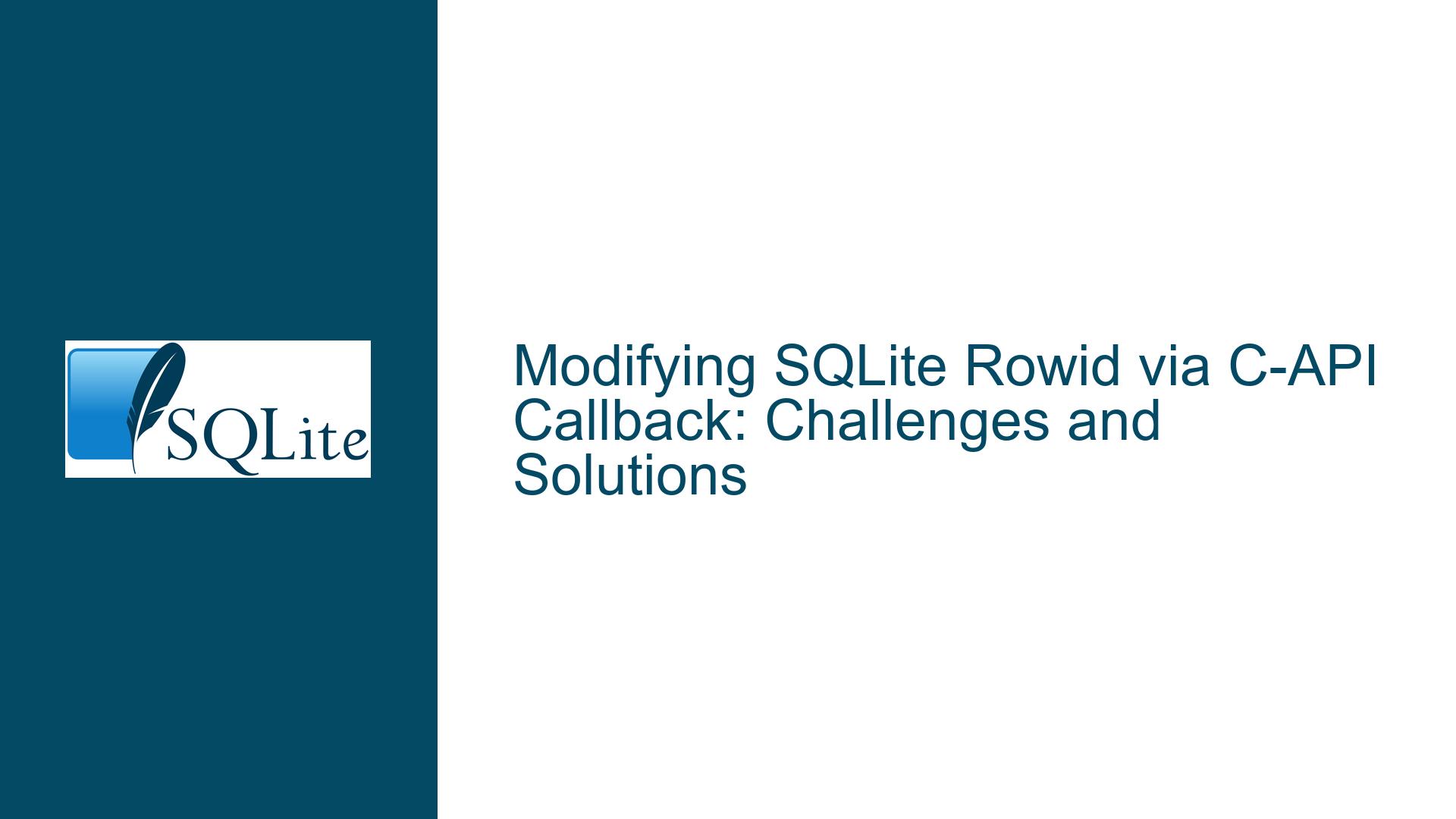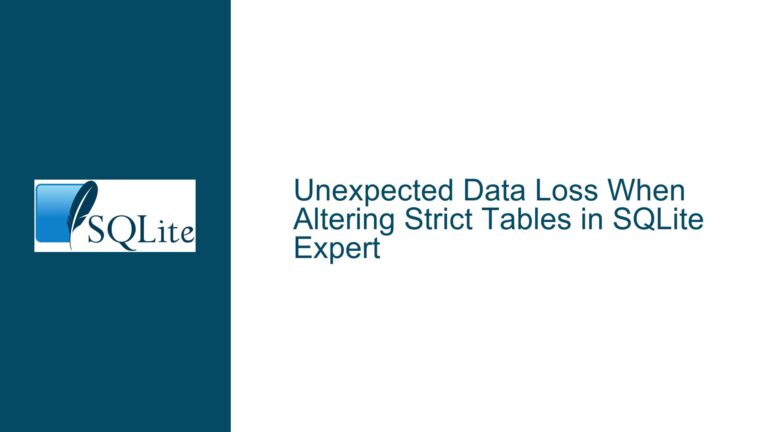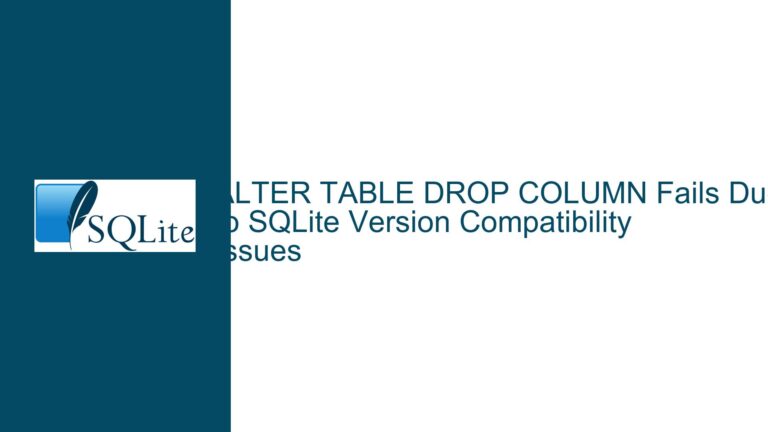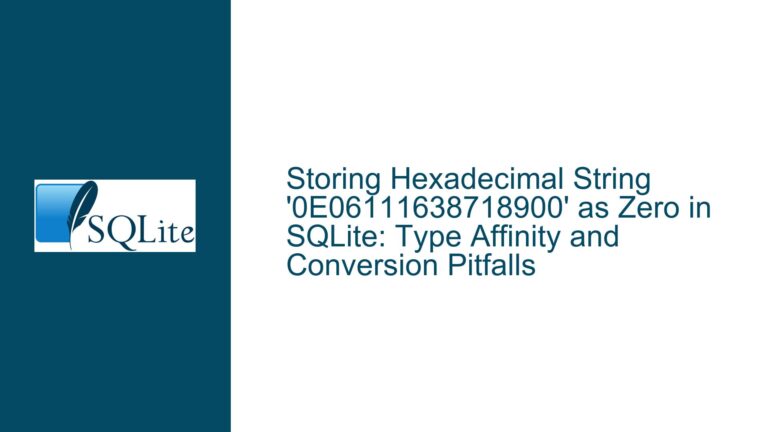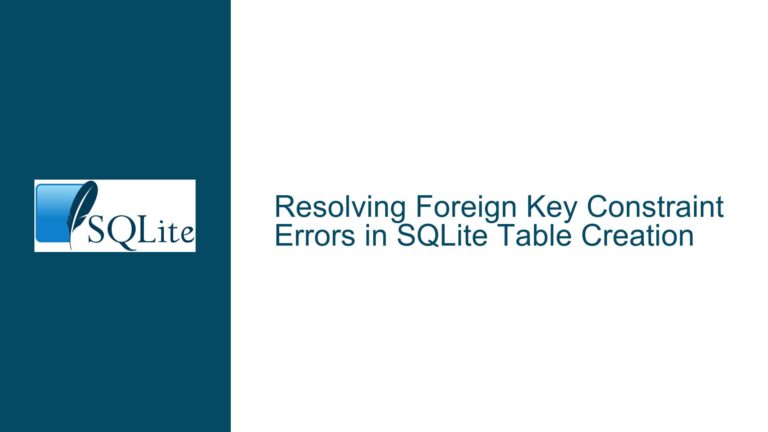Modifying SQLite Rowid via C-API Callback: Challenges and Solutions
Modifying Rowid During Insert in SQLite: Core Issue and Constraints
The core issue revolves around the modification of the rowid in SQLite during an insert operation, specifically when using the C-API. The rowid is a unique identifier for each row in a SQLite table, and it is automatically assigned unless explicitly specified. The challenge arises when attempting to modify the rowid after the initial insert, particularly in scenarios where unique identifiers need to be generated across distributed systems without direct communication.
SQLite’s rowid is inherently ephemeral unless explicitly aliased. This means that unless the rowid is given a specific alias, its value can change unpredictably. This behavior is particularly problematic in distributed systems where unique identifiers must be consistent and predictable across different nodes. The inability to modify the rowid directly through the C-API callback further complicates the issue, as it limits the flexibility of dynamically assigning unique identifiers during the insert operation.
The discussion highlights the need for a robust solution that ensures unique identifiers across distributed nodes without relying on direct communication. The proposed solutions include using WITHOUT ROWID tables, leveraging AUTOINCREMENT, and employing triggers to enforce uniqueness. Each of these solutions has its own set of trade-offs, which must be carefully considered to ensure data integrity and system reliability.
Ephemeral Nature of Rowid and Distributed System Challenges
The ephemeral nature of the rowid in SQLite is a significant factor contributing to the challenges faced in distributed systems. When a table is created without an explicit alias for the rowid, SQLite assigns a unique identifier that can change under certain conditions. This behavior is particularly problematic in distributed systems where each node must generate unique identifiers independently, without the risk of collisions or inconsistencies.
In distributed systems, the need for unique identifiers across different nodes is critical. Without a mechanism to ensure that each node generates unique identifiers, there is a risk of data corruption and inconsistencies. The rowid in SQLite, being ephemeral, does not provide a reliable mechanism for generating such unique identifiers. This limitation necessitates the use of alternative strategies, such as WITHOUT ROWID tables or AUTOINCREMENT, to ensure that each node can generate unique identifiers without the risk of collisions.
The use of WITHOUT ROWID tables allows for the creation of tables with a composite primary key, which can include a location identifier to ensure uniqueness across different nodes. This approach, while effective, requires significant changes to the schema and may not be feasible in all scenarios. Alternatively, the use of AUTOINCREMENT can provide a mechanism for generating unique identifiers, but it requires careful management of the sqlite_sequence table to ensure that each node starts with a unique range of identifiers.
Triggers can also be used to enforce uniqueness and manage the assignment of unique identifiers. However, this approach introduces additional complexity and may not be suitable for all use cases. The choice of solution depends on the specific requirements of the system and the constraints imposed by the distributed environment.
Implementing WITHOUT ROWID Tables and Triggers for Unique Identifiers
The implementation of WITHOUT ROWID tables and triggers provides a robust solution for generating unique identifiers in distributed systems. By using a composite primary key that includes a location identifier, each node can generate unique identifiers without the risk of collisions. This approach requires careful planning and design to ensure that the schema supports the required functionality.
The first step in implementing this solution is to create a WITHOUT ROWID table with a composite primary key. The primary key should include a location identifier and an integer column to ensure uniqueness within each node. For example:
CREATE TABLE distributed_table (
location_id INTEGER,
unique_id INTEGER,
data TEXT,
PRIMARY KEY (location_id, unique_id)
) WITHOUT ROWID;
In this example, the location_id column is used to identify the node, and the unique_id column is used to ensure uniqueness within that node. The PRIMARY KEY constraint ensures that each combination of location_id and unique_id is unique across the entire table.
Triggers can be used to enforce additional constraints and manage the assignment of unique identifiers. For example, a trigger can be created to ensure that the unique_id column is always incremented and does not exceed a predefined range:
CREATE TRIGGER enforce_unique_id
BEFORE INSERT ON distributed_table
FOR EACH ROW
BEGIN
SELECT RAISE(ROLLBACK, 'Unique ID out of range')
WHERE NEW.unique_id > 1000000;
END;
This trigger ensures that the unique_id column does not exceed the predefined range, preventing potential issues with identifier overflow. The use of triggers adds an additional layer of control and ensures that the unique identifiers are managed correctly.
The combination of WITHOUT ROWID tables and triggers provides a robust solution for generating unique identifiers in distributed systems. This approach ensures that each node can generate unique identifiers without the risk of collisions, while also providing additional control over the assignment of identifiers. However, it is important to carefully design the schema and triggers to ensure that they meet the specific requirements of the system.
Leveraging AUTOINCREMENT and sqlite_sequence for Unique Identifier Ranges
The use of AUTOINCREMENT and the sqlite_sequence table provides another solution for generating unique identifiers in distributed systems. By carefully managing the sqlite_sequence table, each node can be assigned a unique range of identifiers, ensuring that there are no collisions between nodes.
The AUTOINCREMENT keyword in SQLite ensures that each new row inserted into a table is assigned a unique identifier that is one greater than the largest rowid currently in the table. The sqlite_sequence table is used to track the current value of the AUTOINCREMENT sequence for each table. By modifying the sqlite_sequence table, it is possible to set the starting value for the AUTOINCREMENT sequence, allowing each node to be assigned a unique range of identifiers.
For example, consider a table with an AUTOINCREMENT primary key:
CREATE TABLE unique_table (
id INTEGER PRIMARY KEY AUTOINCREMENT,
data TEXT
);
Before inserting any rows into the table, the sqlite_sequence table can be modified to set the starting value for the AUTOINCREMENT sequence:
UPDATE sqlite_sequence
SET seq = 1000000
WHERE name = 'unique_table';
In this example, the starting value for the AUTOINCREMENT sequence is set to 1000000, ensuring that the first row inserted into the table will have an id of 1000001. By assigning a unique starting value to each node, it is possible to ensure that there are no collisions between nodes.
It is important to note that once the sqlite_sequence table has been modified, no further rows should be inserted into the table from other nodes. This ensures that the assigned range of identifiers remains unique to the node. If additional rows need to be inserted, the sqlite_sequence table should be updated again to assign a new range of identifiers.
The use of AUTOINCREMENT and the sqlite_sequence table provides a simple and effective solution for generating unique identifiers in distributed systems. However, it requires careful management of the sqlite_sequence table to ensure that each node is assigned a unique range of identifiers. This approach is particularly useful in scenarios where the number of nodes is limited and the range of identifiers can be easily managed.
Conclusion: Best Practices for Managing Unique Identifiers in SQLite
Managing unique identifiers in SQLite, particularly in distributed systems, requires careful consideration of the constraints and limitations of the rowid and AUTOINCREMENT mechanisms. The ephemeral nature of the rowid and the need for unique identifiers across distributed nodes necessitate the use of alternative strategies, such as WITHOUT ROWID tables, triggers, and careful management of the sqlite_sequence table.
The implementation of WITHOUT ROWID tables with composite primary keys provides a robust solution for ensuring unique identifiers across distributed nodes. By including a location identifier in the primary key, each node can generate unique identifiers without the risk of collisions. Triggers can be used to enforce additional constraints and manage the assignment of unique identifiers, adding an additional layer of control.
The use of AUTOINCREMENT and the sqlite_sequence table provides another effective solution for generating unique identifiers. By assigning a unique range of identifiers to each node, it is possible to ensure that there are no collisions between nodes. However, this approach requires careful management of the sqlite_sequence table and may not be suitable for all scenarios.
Ultimately, the choice of solution depends on the specific requirements of the system and the constraints imposed by the distributed environment. By carefully designing the schema and leveraging the available mechanisms in SQLite, it is possible to ensure that unique identifiers are managed effectively and consistently across distributed nodes.
